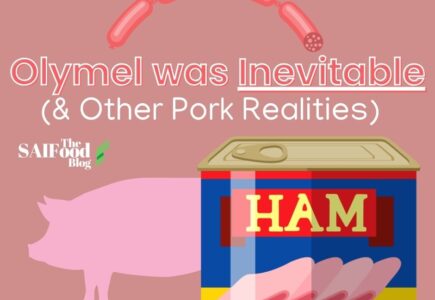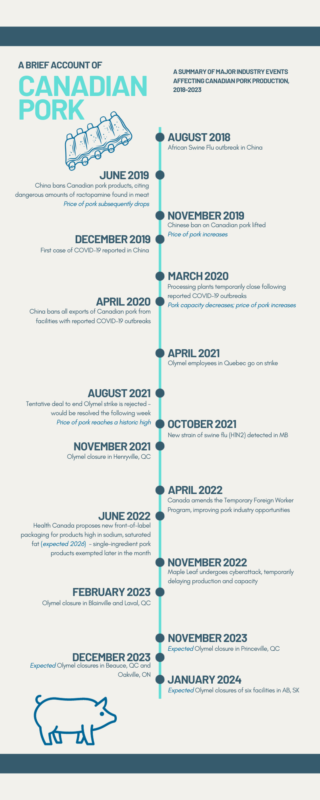In May of this year, Canadian pork giant, Olymel, announced that its series of processing plant closures in eastern Canada would be expanding into the prairies. To economists, the loss of processing sites in Quebec, Saskatchewan, and Alberta were foretold – the natural conclusion to years of poor market performance, limited market accessibility, and outdated facilities. Truly, this story appears to be a case of failing business, as Olymel has been slowly losing its market competitiveness since 2017, but the external demand issues associated with the decision to scale back have implications beyond a single corporation.
Much like with many agricultural commodities, Canada is a major exporter of pork. Our standing in international markets is built on a reputation for quality and accountability, allowing hog production to nearly double since the 1980s. Although from a meat volume perspective, that capacity difference is much less exuberant, as Canadian hogs are largely destined for international slaughter and foreign pork markets. That international success would not be possible without the commitment to evolve animal care and food safety/quality standards to keep Canada third in global pork exports. The stability speaks to the flexibility of pork producers who often fall victim to trade disputes and changing consumption trends, and yet deliver quality that maintains reputation.
The International Pigsty
The last five years have yielded a variety of new challenges to the pork industry, but one of the most stressful components has been the degree of change in international markets. In what has since been described as a political play rather than an accusation of substance, China’s 2019 ractopamine ban of Canadian pork was lifted in fall of that year. (Ractopamine is a feed additive used to improve the quality and efficiency of weight gain in hogs, although is not universally used in Canada.) Following the claim, the price of pork rose, notably off-trend for fall/winter markets. It would only be a few more months before the COVID-19 pandemic would sweep across the planet, locking international trade and, ultimately, forcing domestic adaptability. Not only were Canadian slaughter facilities forced to process the additional influx of hogs that would have traveled over borders to the United States, but indirect cost of living effects from various global conflicts are still being felt by our farmers and consumers today.
This is not said to discourage Canadian pork since the status of our (typical) husbandry practices and quality of meat still matter to trade partners and consumers; the reality of the market is that the industry has had to adapt. For Olymel, the strategy was scaling back production capacity (despite the challenges it added to local farmers); in the foreign marketplace, the strategy comprised selling the products China rejected to Mexico and the Philippines. Discussions around opening European markets could similarly improve the status and profitability of Canadian pork, if the voice of the producer is loud enough at the table. While taking advantage of emerging opportunities aids the sustainability of the pork industry, the subsequent reliance on domestic production (in the absence of trade stability) has revealed industry sensitivities.
Take, for instance, the effects of climate change that have led to reduced rainfall, shorter growing seasons, and increased drought incidence. These conditions, while completely independent of the farmer, impact each farm’s ability to feed their hogs – without adequate barley growth or sty quality, pigs are unable to meet dietary requirements for the meat we’re used to seeing on grocery shelves. Further stress to animal feed markets in the last couple years has caused the cost of production to increase, ultimately becoming an unprofitable venture for farmers already experiencing market risks. With recent inflation trends, western provinces in particular have watched hog farmers walk away from the industry, also citing lack of international market security and domestic disinterest for the business decision. With such strong external forces, it may be worth exploring how our value on domestic pork has softened resiliency.
Not Enough Ham
Partially in response to conflicting health information, consumers have spent the last 40 years trending away from red meat in favor of leaner animal proteins (or none at all). In fact, most Canadians are consuming less than one serving of red meat per day, not necessarily a health risk if the associated macronutrients can be adequately supplemented from other food sources. However, Canadians are advantaged in that market shocks as a result of pandemics and trade discourse have been largely unfelt by consumers. That is, while the price of pork has increased with the inflation of most commodities, the degree to which it has been costlier to enjoy a pork chop is less than that for steak. While pork purchases in Canada have decreased across the decades, the prioritization has shifted to processed products such as sausages and bacon which require less meat per unit than, say, a bone-in ham. Trends such as these may partially explain why we have yet to experience the impacts of farm and processing plant closures.
Regardless, it appears as though hog production is unlikely to disappear entirely, with the last five years largely referred to as a period of change for the industry rather than an apocalyptic end. Wholesale cut purchases could be improved by reminding local consumers of product quality; as recently as this year, industry stakeholders are working to develop a grading system similar to the AAA system used for beef. Performance uncertainty in agricultural commodities is a permanent fixture, but understanding threats and opportunities to pork production can improve resiliency and protect our meat industries.



